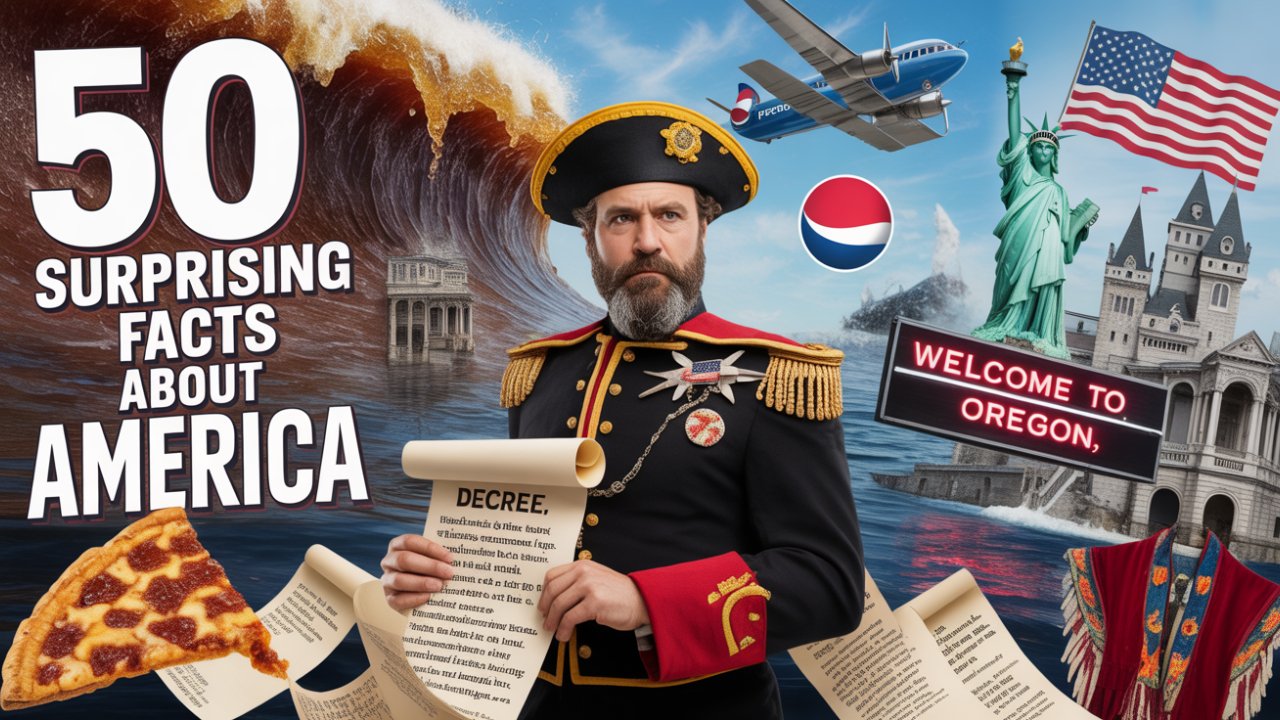You think you know America? The land of Hollywood, the Statue of Liberty, and a self-proclaimed Emperor who ruled for 25 years?
What if I told you that Pepsi once owned a fleet of warships? Or that there’s a town in Oregon called ‘Boring’ that’s officially partnered with a town in Scotland called ‘Dull’?
Get ready to have your view of the United States turned upside down. We’re counting down 50 surprising, shocking, and downright weird facts about America that you probably didn’t learn in history class. Let’s get started.
Fact 1: The United States once had an Emperor. It sounds like a tall tale, but for 25 years, San Francisco was watched over by its very own emperor. In 1859, a failed businessman named Joshua Norton declared himself “Emperor of these United States.” Instead of being laughed out of town, the people of San Francisco just rolled with it. Emperor Norton I became a local celebrity, rocking a military-style uniform, inspecting the city streets, and even issuing his own currency, which many local shops actually accepted. He famously issued decrees ordering the U.S. Congress to dissolve, and while the government ignored him, the local papers printed them. His reign showed that San Francisco was a place where eccentricity wasn’t just tolerated it was celebrated.
Fact 2: Pepsi once acquired a Soviet naval fleet. In a wild twist of Cold War economics, PepsiCo briefly became the owner of a formidable naval fleet. By the late 1980s, Pepsi was huge in the Soviet Union, but the ruble was worthless internationally. So, they bartered. At first, Pepsi traded its soda for Stolichnaya vodka to sell in the U.S. But as the deal grew, the Soviets needed a new way to pay. In 1989, they offered Pepsi a deal for a fleet of warships, including 17 submarines, a cruiser, a frigate, and a destroyer. This led to the popular myth that Pepsi had the world’s 6th largest navy. While a fun story, it was an exaggeration. Pepsi’s CEO famously joked to the National Security Advisor, “We’re disarming the Soviet Union faster than you are.” The company had no plans for a cola war on the high seas; they immediately sold the entire fleet for scrap metal.
Fact 3: Boston was once flooded by molasses. On January 15, 1919, a disaster of a uniquely sticky nature hit Boston’s North End. A massive, 50-foot-tall tank holding over two million gallons of molasses suddenly burst. This triggered the Great Molasses Flood, a wave of goo estimated to be 25 feet high at its peak, which smashed through the streets at 35 miles per hour. The wave was so powerful it ripped buildings from their foundations and crumpled elevated railway tracks. The bizarre tragedy killed 21 people and injured 150 more. The cleanup was a massive job, and people said that on hot summer days, you could still smell the sweet scent of molasses for decades.
Fact 4: The largest armed uprising since the Civil War happened in West Virginia. Here’s a chapter of American history that’s rarely taught in schools. The West Virginia Coal Wars were a period of intense and violent labor disputes. It all came to a head in August 1921 with the Battle of Blair Mountain. For five days, an army of around 10,000 armed coal miners, many of them World War I vets, fought against 3,000 lawmen and strikebreakers. The miners wanted the right to unionize and to end the oppressive company town system. The fighting got so bad that private planes were hired to drop homemade bombs on the miners. The battle only ended when the U.S. Army arrived, but it remains a bloody reminder of how far American workers have gone to fight for their rights.
Fact 5: A Native American tribe saved George Washington’s army. During the brutal winter of 1777-1778, the Continental Army was starving at Valley Forge. Morale was at an all-time low. At this critical moment, the Oneida Nation, one of the few tribes that sided with the Americans, came to the rescue. An Oneida group, led by a woman named Polly Cooper, traveled hundreds of miles through the snow carrying baskets of white corn. This was a lifesaver, but the starving soldiers had no idea how to cook it. So Polly Cooper stayed with the army all winter, teaching them how to prepare the corn and nursing the sick back to health. It’s said that Martha Washington gave Polly a shawl as a gift of thanks, which is still preserved by the Oneida Nation today.
Fact 6: The first atomic bomb was developed in New Mexico. In the middle of World War II, a top-secret project that would change the world forever was underway in the New Mexico desert. This was the Manhattan Project, a massive scientific effort with one goal: build the world’s first atomic bomb. The project gathered some of the world’s brightest scientists at a secret lab in Los Alamos. Their work came to a head on July 16, 1945, with the Trinity test, where the first nuclear device was detonated, unleashing a terrifying new power. The event didn’t just change the course of the war; it kicked off the atomic age, forever changing global politics and warfare.
Fact 7: The Wright Brothers’ historic flight took place in North Carolina. While Orville and Wilbur Wright were from Dayton, Ohio, where they designed and built their plane, they chose the windy dunes of Kitty Hawk, North Carolina, for their experiments. Why? They needed a place with strong, steady winds and soft sand for crash landings. On December 17, 1903, they finally did what many thought was impossible. Orville flew the Wright Flyer for 12 seconds, traveling 120 feet. It was the first successful, sustained, and controlled powered flight in history. It may have been a short hop, but it was a giant leap for humanity that launched the age of aviation.
Fact 8: The U.S. almost had a three-person presidency. The 1876 presidential election was so messy it almost tore the nation apart, just a decade after the Civil War. The results were so disputed that it took months to figure out who won. In the middle of all the chaos, a wild idea was floated to stop this from ever happening again. Some folks in Pennsylvania suggested a constitutional amendment to replace the single president with a three-person executive council, kind of like the triumvirates of ancient Rome. The idea was that a rotating leadership could better represent a divided nation. The proposal never got serious support in Congress, but it shows just how unstable things were.
Fact 9: A constitutional amendment was proposed to outlaw millionaires. During the Great Depression in 1933, the gap between the rich and poor was enormous. In response, a congressman from Washington named Wesley Lloyd introduced a truly radical idea: a constitutional amendment to make it illegal to be a millionaire. The proposal said that any personal income over one million dollars a year would be taken by the government to pay down the national debt. It was a dramatic attempt to redistribute wealth. Unsurprisingly, the idea didn’t get very far with his fellow congressmen, many of whom were millionaires themselves.
Fact 10: An amendment was passed to protect slavery forever. Just before the Civil War, in a desperate, last-ditch effort to stop the southern states from seceding, Congress passed a constitutional amendment that’s mostly forgotten today. The Corwin Amendment, passed in March 1861, would have made it impossible for the federal government to interfere with slavery in the states. Its text stated that “No amendment shall be made to the Constitution which will authorize or give to Congress the power to abolish or interfere” with a state’s “domestic institutions.” Abraham Lincoln even said in his first inaugural address he had “no objection” to it. It was a chilling compromise, but the start of the war made it irrelevant, and it was eventually replaced by the 13th Amendment, which abolished slavery.
Fact 11: You can be arrested for disrupting church in Mississippi. You may have heard a myth that yawning too loudly in a Mississippi church can get you arrested. While that specific claim is misleading, it’s rooted in a real law. A state statute makes it a misdemeanor to intentionally disturb a religious congregation. The law was meant to stop serious disruptions, not sleepy churchgoers. But its broad wording means that technically, any act designed to interrupt a service could get you in trouble, which is likely where the funny but false yawning example came from.
Fact 12: In Missouri, it’s legal for neighbors to castrate a roaming bull. This law sounds like it was pulled straight from the Wild West. In Missouri, there’s an unusual statute to deal with wandering livestock. If a bull younger than one year is found roaming free for three days, and the owner can’t be found or won’t contain it, any three neighbors can legally take matters into their own hands. They are allowed to castrate the animal, as long as they have three witnesses. The law was likely created to prevent uncontrolled breeding in a rural, agricultural society.
Fact 13: In Alabama, wearing a fake mustache in church is illegal if it causes laughter. Some old laws are just fantastically specific. In Alabama, there’s a law on the books that makes it illegal to wear a fake mustache in church for the purpose of making people laugh. This wasn’t about fashion; it was about decorum. The law was designed to prevent people from disrupting the solemnity of a religious service with silly pranks. While you’re not likely to get arrested for it today, it remains a hilarious example of old-timey legislation.
Fact 14: In Vermont, women once needed their husband’s permission for dentures. This law is a startling relic of a different time. In Vermont, a law that is technically still on the books required a married woman to get her husband’s written permission before she could get false teeth. The idea behind it was that a woman’s physical appearance, and even her health decisions, were controlled by her husband. This law is obviously not enforced today and would be a clear violation of modern principles, but it’s a powerful reminder of how much legal rights and social norms have changed.
Fact 15: The Third Amendment is almost never used. Every American student learns about the Bill of Rights, but one of its amendments is so specific it’s almost a piece of historical trivia. The Third Amendment stops the government from forcing you to house soldiers in your home during peacetime. This was a direct response to the British practice of forcing colonists to house Redcoats. In modern times, with a professional military housed on bases, the issue just doesn’t come up anymore. In fact, the Third Amendment is the least-argued part of the Constitution and has never been the main basis for a Supreme Court decision.
Fact 16: Lollipops were invented in Connecticut. That simple, sweet treat on a stick has its roots in New Haven, Connecticut. Around 1908, a man named George Smith started putting hard candies on sticks. He named them “Lolly Pops” after a popular racehorse of the time, Lolly Pop. The name stuck, and by the 1920s, the candy was a national hit. So, the next time you enjoy a lollipop, you can thank a Connecticut candy maker with a love for horse racing.
Fact 17: KFC was born in a Kentucky gas station. Kentucky Fried Chicken is a global empire, but it started out much more humbly. Colonel Harland Sanders first started selling his famous fried chicken not in a restaurant, but from a roadside motel and gas station he owned in Corbin, Kentucky, during the 1930s. His cooking got so popular that he was named an honorary Kentucky Colonel for his contribution to the state’s food scene. The first official KFC franchise didn’t open until 1952 in Utah, but the secret recipe of 11 herbs and spices was perfected in that little Kentucky town.
Fact 18: The U.S. is a nation of diverse pizza styles. Pizza may be Italian, but America has adopted it and made it its own. Beyond the classic, foldable New York slice, there’s Chicago deep-dish, a beast of a pizza that’s more like a casserole. Detroit-style pizza is rectangular with a thick, crispy, cheese-crusted edge. St. Louis pizza has a cracker-thin crust and uses a unique processed cheese called Provel. There’s even New Haven-style “apizza,” a thin, coal-fired pie. This incredible variety shows how good America is at taking something beloved and reinventing it in countless delicious ways.
Fact 19: All five of the biggest theme parks are Disney parks. When it comes to theme parks in the U.S., one name owns the playground: Disney. In terms of annual visitors, the top five most popular theme parks in the country are all Disney-owned. The list is led by the Magic Kingdom at Walt Disney World in Florida, followed by Disneyland in California. The other top spots are also in Florida: Animal Kingdom, Epcot, and Hollywood Studios. This complete dominance shows the massive appeal of Disney’s brand of immersive storytelling and beloved characters.
Fact 20: The largest shopping mall in America is in Pennsylvania. Many people think the Mall of America in Minnesota is the biggest, and it is the largest by total area, thanks to its famous indoor theme park. But the title of the largest shopping mall, based on sheer retail space, actually belongs to the King of Prussia Mall in Pennsylvania. Located outside Philadelphia, this massive complex has over 450 stores. It’s a true paradise for shoppers and a monument to the American love affair with the shopping mall.
Fact 21: The world’s largest tree is in California. In California’s Sequoia National Park stands a living giant: the General Sherman Tree. It might not be the absolute tallest or widest tree, but by sheer volume, it’s the largest single-stem tree on Earth. This magnificent sequoia is around 2,200 years old and stands over 275 feet tall. To put its size in perspective, the volume of its trunk is equal to more than half the volume of an Olympic-sized swimming pool. It’s a humbling sight and a living monument to the power of nature.
Fact 22: Colorado has the highest average elevation. Known for the Rocky Mountains, it’s no shock that Colorado is a state of great heights. But what’s really amazing is that it has the highest average elevation of any U.S. state, at a staggering 6,800 feet above sea level. The entire state sits above 3,300 feet. Colorado is home to over 50 peaks that soar above 14,000 feet, which locals call “fourteeners.” This high-altitude landscape makes Colorado a true top-of-the-world destination.
Fact 23: The deepest lake in the U.S. is in Oregon. Crater Lake in Oregon is a natural wonder of incredible beauty and depth. At 1,949 feet deep, it’s the deepest lake in the United States. The lake was formed around 7,700 years ago when a volcano, Mount Mazama, erupted and collapsed in on itself. What makes Crater Lake so stunning is its famously clear, intensely blue water. It’s fed almost entirely by rain and snow, making it one of the purest lakes on the planet.
Fact 24: North America’s tallest mountain is in Alaska. Towering over the Alaskan wilderness is the massive peak of Denali, formerly known as Mount McKinley. At 20,310 feet, it’s the tallest mountain in North America. What makes Denali look so imposing is its dramatic vertical rise. From its base to its peak, it rises about 18,000 feet a greater vertical relief than even Mount Everest. The mountain’s extreme weather makes it one of the most challenging climbs in the world and a powerful symbol of the American frontier.
Fact 25: The world’s largest freshwater lake is partially in the U.S. Lake Superior, one of the five Great Lakes, is so huge it feels like an inland ocean. By surface area, it is the largest freshwater lake in the world, holding 10 percent of the world’s surface fresh water. Bordered by Canada and the U.S. states of Minnesota, Wisconsin, and Michigan, the lake is known for its cold, clear water and rugged coastline. Its immense size and powerful storms have claimed countless ships, making it a place of both stunning beauty and serious power.
Fact 26: The world’s first national park is in Wyoming. In 1872, the United States did something the world had never seen before: it set aside a massive piece of land for the people, creating the world’s first national park. That park was Yellowstone. Located mostly in Wyoming, Yellowstone is a geothermal wonderland sitting on top of a supervolcano. It has more geysers and hot springs than anywhere else on Earth, including the famous Old Faithful. The creation of Yellowstone was a revolutionary idea that kicked off a worldwide national park movement.
Fact 27: Nevada is home to hundreds of ghost towns. Nevada’s history is all about mining booms and busts. In the 19th and early 20th centuries, people flocked to the state looking for gold and silver, creating busy towns overnight. But when the mines dried up, the towns were often abandoned just as quickly. Today, Nevada has over 600 ghost towns scattered across its deserts. While the popular claim that it has more ghost towns than populated ones is debated, the sheer number of them is staggering. Towns like Rhyolite offer a fascinating look into the past, with crumbling buildings and silent streets that echo the Wild West.
Fact 28: Minnesota isn’t the state with the most lakes. Minnesota proudly calls itself the “Land of 10,000 Lakes,” and it actually has over 11,800. But the state that really holds the title is Alaska. The Last Frontier is home to an incredible number of lakes over 3 million of them. Its vast, untouched wilderness contains a massive network of waterways, from tiny ponds to giant lakes. So, while Minnesota’s nickname is well-earned, Alaska takes the crown for the most lakes in the nation.
Fact 29: The U.S. is the only country with all five major climate zones. The United States is a country of incredible geographic diversity, and its climate proves it. It’s the only country in the world that has all five major climate zones: tropical, dry, temperate, continental, and polar. You can find a tropical climate in Florida and Hawaii, a dry desert in the Southwest, a temperate climate in the Southeast, a continental climate in the Midwest and Northeast, and a polar climate in Alaska. It’s like a microcosm of the world’s climates all in one country.
Fact 30: Rhode Island has the longest official name. Rhode Island may be the smallest state by area, but until very recently, it had the longest official name: the “State of Rhode Island and Providence Plantations.” This mouthful of a name came from the merger of two original colonies. For centuries, this was the official name, though everyone just called it “Rhode Island.” In 2020, voters finally approved shortening the name, partly because of the negative history associated with the word “plantations.”
Fact 31: Texas was once an independent country. Before it became the 28th state, Texas was its own nation: the Republic of Texas. After winning independence from Mexico in 1836, Texas existed as a sovereign country for nearly ten years. It had its own president, congress, and money, and even had diplomatic relations with countries like the U.S. and France. The “Lone Star” on its flag is a symbol of this independent period. In 1845, Texas was annexed by the United States, but this unique history contributes to the fierce pride and independent spirit of Texans today.
Fact 32: Utah is home to five iconic national parks. For anyone who loves dramatic landscapes, Utah is a dream come true. The state has an incredible concentration of natural beauty, including five stunning national parks known as the “Mighty 5.” These parks are Zion, with its towering cliffs; Bryce Canyon, famous for its otherworldly rock spires called hoodoos; Arches, home to over 2,000 natural stone arches; Canyonlands, a rugged landscape carved by the Colorado River; and Capitol Reef, known for a massive “wrinkle” in the earth’s crust.
Fact 33: Vermont is the king of maple syrup. When you think of maple syrup, you should think of Vermont. While Canada produces the most in the world, inside the U.S., Vermont is the undisputed leader. The Green Mountain State produces more maple syrup than any other state, usually about half of the total U.S. production. Tapping maple trees is a cherished tradition in Vermont, a rite of spring that’s a huge part of the state’s culture and economy.
Fact 34: Wisconsin is America’s Dairyland. Wisconsin’s nickname, “America’s Dairyland,” is no joke. The state is a cheese-making powerhouse, producing more cheese than any other state. In fact, if Wisconsin were its own country, it would rank fourth in the world for cheese production. It’s famous for cheddar, but its cheesemakers produce over 600 different kinds. This culture is celebrated with cheese-tasting tours and the famous “cheesehead” hats worn by Green Bay Packers fans.
Fact 35: Nashville is Music City, USA. Nashville, Tennessee, has earned its nickname, “Music City, USA,” for being the heart and soul of country music. It’s home to the Grand Ole Opry, the country’s longest-running live radio show, and the Ryman Auditorium, the “Mother Church of Country Music.” Aspiring musicians from all over the world move to Nashville, hoping to get discovered in the honky-tonks on Broadway. The city’s influence now reaches far beyond country to include a vibrant and diverse music scene.
Fact 36: The oldest public university is in North Carolina. While Harvard is the oldest university overall, the title of the first public university in the United States goes to the University of North Carolina at Chapel Hill. Chartered in 1789, it was the only public university to award degrees in the 18th century. For over 200 years, UNC has been a leading institution in the South, embodying a long and proud tradition of public education.
Fact 37: There are over 570 federally recognized Native American tribes. The United States is home to a diverse and resilient population of indigenous peoples. There are 574 federally recognized Native American and Alaska Native tribes and villages, each with its own unique culture, language, and government. This number reflects the incredible diversity of the original people of North America. These sovereign nations continue to preserve their traditions, govern their lands, and contribute to the rich cultural tapestry of the country.
Fact 38: The Navajo Nation is the largest tribe. Of the hundreds of Native American tribes, the Navajo Nation is the largest, both in population and land area. The Navajo reservation covers over 27,000 square miles an area larger than ten U.S. states stretching across parts of Arizona, New Mexico, and Utah. The Navajo people, or Diné, are known for their beautiful art, like weaving and silverwork, and their complex language, which was famously used as an unbreakable code by the “Code Talkers” in World War II.
Fact 39: Nearly 10 million Americans identify as Native American. According to the U.S. Census Bureau, about 9.7 million people in the United States identify as American Indian or Alaska Native, either alone or combined with other races. This population has been growing, as more people embrace and reclaim their Native heritage. The diversity within this population is huge, with hundreds of different tribal affiliations and experiences.
Fact 40: Hispanics/Latinos are the largest minority group. The demographic landscape of the U.S. is always changing. Today, people of Hispanic or Latino origin are the nation’s largest ethnic minority group, making up nearly 20 percent of the total population. This diverse group includes people with roots in Mexico, Puerto Rico, Cuba, and Central and South America. Their contributions have profoundly shaped American culture, from food and music to politics and the economy.
Fact 41: Protestantism is the largest religious group. The United States is a religiously diverse country, but the largest single religious group is Protestant Christianity. About 40 percent of Americans identify as Protestant, a category that includes a huge variety of denominations like Baptists, Methodists, and Pentecostals. While the percentage of Protestants has declined over the years, with more people identifying as religiously unaffiliated, it remains the dominant religious tradition in the country.
Fact 42: Walmart and Amazon are the biggest employers. In the modern American economy, two giants stand out as the largest private employers: Walmart and Amazon. The retail behemoth Walmart has long been number one, employing over 1.5 million people in the U.S. In recent years, the e-commerce giant Amazon has grown at an explosive rate and is now the second-largest private employer. Together, these two companies employ a huge portion of the American workforce.
Fact 43: The healthiest state is Massachusetts, while the happiest is North Dakota. How do you measure a state’s well-being? According to some recent studies, Massachusetts ranks as the healthiest state, based on factors like access to healthcare and healthy behaviors. Meanwhile, a different set of studies, focusing on things like emotional well-being and community, has found that North Dakota ranks as the happiest state. It’s a fascinating look at how quality of life differs across the country, showing that health and happiness don’t always overlap.
Fact 44: Harvard is the oldest university in the U.S. Founded in 1636, just 16 years after the Pilgrims landed at Plymouth Rock, Harvard University is the oldest institution of higher learning in the United States. It was established by the Massachusetts Bay Colony and named after its first benefactor, John Harvard. For centuries, Harvard has been one of the world’s most prestigious universities, producing presidents, Nobel laureates, and leaders in every field imaginable.
Fact 45: The first college to grant degrees to women was in Ohio. In the 19th century, higher education was almost exclusively for men. But Oberlin College in Ohio was a trailblazer. In 1837, it became the first college in the U.S. to admit women, and in 1841, it made history again by being the first to grant bachelor’s degrees to female students. Oberlin was also a pioneer in racial integration, admitting African American students as early as 1835. Its progressive policies helped pave the way for greater access to education for everyone.
Fact 46: The first free public library opened in New Hampshire. The idea of a library where anyone could borrow books for free was revolutionary. While Benjamin Franklin started the first subscription library in Philadelphia in 1731, the first truly free public library, supported by taxpayers, was founded in Peterborough, New Hampshire, in 1833. This model of a free, public institution for learning became a cornerstone of American democracy and spread across the country.
Fact 47: The first gas station opened in Ohio. As cars started appearing on American roads, a new kind of business was needed to support them. The first dedicated, drive-in gas station opened in Columbus, Ohio, in 1899. Before this, you had to buy gasoline in cans from pharmacies or blacksmiths. This new service station offered a convenient, one-stop shop for fuel, a model that would soon be everywhere. It was a small but crucial innovation that fueled the rise of the automobile.
Fact 48: The first electric traffic light was installed in Cleveland. As cities filled with a chaotic mix of cars, streetcars, and pedestrians, the need for traffic control was desperate. On August 5, 1914, the world’s first electric traffic signal was installed at a corner in Cleveland, Ohio. Designed by James Hoge, it had red and green lights and a buzzer to warn when the signal was about to change. A police officer in a booth controlled the lights. This Cleveland invention was a groundbreaking step in urban safety that would change cities forever.
Fact 49: Avoiding eye contact is considered rude. Here’s a tip if you’re ever visiting the U.S.: make eye contact. In many cultures, direct eye contact can be seen as aggressive, but in the United States, it’s generally the opposite. Making eye contact when you’re talking to someone is seen as a sign of honesty, confidence, and sincerity. Avoiding someone’s gaze can be interpreted as being insecure or even untrustworthy. It’s an important part of American social etiquette.
Fact 50: Tipping and small talk are common customs. Two social customs that are deeply baked into American life are tipping and making small talk. Tipping service workers, like waiters and bartenders, isn’t just a nice gesture it’s an expected practice, as many workers rely on tips for their income. Small talk, or making polite conversation about unimportant things with strangers, is also a common social lubricant. Chatting about the weather or asking “How are you?” is a way of being friendly and acknowledging other people.
And there you have it 50 facts that prove the United States is more surprising, strange, and fascinating than you ever imagined. From an emperor in San Francisco to a fleet of warships owned by a soda company, American history is filled with unbelievable truths.
If you learned something new and had your mind blown, do us a favor and hit that like button. And for more incredible stories from history and culture, make sure you subscribe and turn on notifications so you never miss an update.
What was your favorite fact on this list? Was there anything that completely shocked you? Let us know in the comments below. We love hearing from you.
From sea to shining sea, America is a land of contradictions a place of incredible innovation, bizarre laws, and a history that is truly stranger than fiction. It just goes to show, no matter how much you think you know, there’s always another surprising story waiting to be discovered. Thanks for watching, and we’ll see you in the next video.





